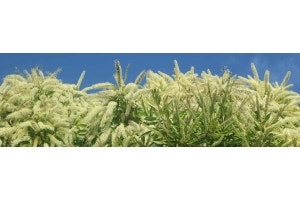
Variegation in plants means colour all year in the garden. Variegated plants are ideal for the Australian climate, as they thrive in bright light. They need a little different care to an all-green plant - find out how to keep your variegated plants looking perfect here.
“Variegation” means when the leaves of a plant are partly green, and mixed with another colour or colours – this is usually cream, white or yellow, but it can be a brighter contrast such as pink. The extra colour can appear as a stripe along the edge or centre of the leaf; as spots and freckles; or in random splashes.
 Sometimes variegation is very regular and even, on all leaves of every plant; sometimes the colour is variable, with some leaves more colourful, or some plants brighter than others. Sometimes variegation happens more on young leaves (like photinia here), and sometimes it takes a while for the colour to develop (as in cordylines).
Sometimes leaves spontaneously decide to develop a cream stripe down the centre, or a freckling of golden spots. This is called a "sport". Plant breeders deliberately develop plants with paler leaf markings, or select out sports with white or coloured patterns for specialist propagation that retains the distinctive leaf colours.
Variegated plants are among the most popular plants in our range. The light-coloured leaves brighten up dark spots in the garden, and give an extra level of interest all year round.
Sometimes variegation is very regular and even, on all leaves of every plant; sometimes the colour is variable, with some leaves more colourful, or some plants brighter than others. Sometimes variegation happens more on young leaves (like photinia here), and sometimes it takes a while for the colour to develop (as in cordylines).
Sometimes leaves spontaneously decide to develop a cream stripe down the centre, or a freckling of golden spots. This is called a "sport". Plant breeders deliberately develop plants with paler leaf markings, or select out sports with white or coloured patterns for specialist propagation that retains the distinctive leaf colours.
Variegated plants are among the most popular plants in our range. The light-coloured leaves brighten up dark spots in the garden, and give an extra level of interest all year round.
 If you enjoy growing plants with different coloured leaves you might have noticed that occasionally they will sprout a random stem or branch with all-green leaves. The leaves on that particular branch or stem have not got the white, yellow or pink colouration that the rest of the plant has.
This habit - of the stem growing all-green leaves – is called “reversion”.
If you enjoy growing plants with different coloured leaves you might have noticed that occasionally they will sprout a random stem or branch with all-green leaves. The leaves on that particular branch or stem have not got the white, yellow or pink colouration that the rest of the plant has.
This habit - of the stem growing all-green leaves – is called “reversion”.
Sometimes the plant ‘forgets’ that it is variegated, and starts to grow green stems. The plant is reverting to its default state of all green.
An all-green leaf is more efficient at photosynthesising than a partly-green one. So an all-green stem will grow more strongly than a variegated one.
Keep in mind what kind of variegated plant you have. Some of them are all-green to start with, when they are young, and only develop bright leaf colour after they have grown for a while. Don't snip any green stems out if you have one of these plants! If your plant is looking variegated but not as strongly as before, a good feed and some brighter light should see it right. Snip away densely overhanging shrubs in the border to give it a little more sunshine; or move houseplants to a brighter spot indoors.
Varieties of Variegation
 Sometimes variegation is very regular and even, on all leaves of every plant; sometimes the colour is variable, with some leaves more colourful, or some plants brighter than others. Sometimes variegation happens more on young leaves (like photinia here), and sometimes it takes a while for the colour to develop (as in cordylines).
Sometimes leaves spontaneously decide to develop a cream stripe down the centre, or a freckling of golden spots. This is called a "sport". Plant breeders deliberately develop plants with paler leaf markings, or select out sports with white or coloured patterns for specialist propagation that retains the distinctive leaf colours.
Variegated plants are among the most popular plants in our range. The light-coloured leaves brighten up dark spots in the garden, and give an extra level of interest all year round.
Sometimes variegation is very regular and even, on all leaves of every plant; sometimes the colour is variable, with some leaves more colourful, or some plants brighter than others. Sometimes variegation happens more on young leaves (like photinia here), and sometimes it takes a while for the colour to develop (as in cordylines).
Sometimes leaves spontaneously decide to develop a cream stripe down the centre, or a freckling of golden spots. This is called a "sport". Plant breeders deliberately develop plants with paler leaf markings, or select out sports with white or coloured patterns for specialist propagation that retains the distinctive leaf colours.
Variegated plants are among the most popular plants in our range. The light-coloured leaves brighten up dark spots in the garden, and give an extra level of interest all year round.
Bright Light = Bright Leaf
The paler parts of the leaf have less chlorophyll in them, which means the plant can't photosynthesise (turn sunlight into energy) as much as it can in an all-green plant. Which means variegated plants need locations with brighter light - perfect for our Australian climate! They also do well in part shade as they add a lighter colour to mixed borders, a contrast to dark green hedges and shrubs, providing they get sufficient light for part of the day. Australian light is very strong so a few hours is enough.Reversion = No More Variegation
 If you enjoy growing plants with different coloured leaves you might have noticed that occasionally they will sprout a random stem or branch with all-green leaves. The leaves on that particular branch or stem have not got the white, yellow or pink colouration that the rest of the plant has.
This habit - of the stem growing all-green leaves – is called “reversion”.
If you enjoy growing plants with different coloured leaves you might have noticed that occasionally they will sprout a random stem or branch with all-green leaves. The leaves on that particular branch or stem have not got the white, yellow or pink colouration that the rest of the plant has.
This habit - of the stem growing all-green leaves – is called “reversion”.
What is wrong with your plant?
Variegated plants are often grown from one original all-green plant that spontaneously grew a colour-splashed stem - a sport. To keep the colour variegation the plant usually has to be grown vegetatively – this means that we take cuttings or tissue material from the colour-splashed part to make new plants.Sometimes the plant ‘forgets’ that it is variegated, and starts to grow green stems. The plant is reverting to its default state of all green.
An all-green leaf is more efficient at photosynthesising than a partly-green one. So an all-green stem will grow more strongly than a variegated one.
What you can do about reverted stems?
If you don’t want your variegated plant to revert to an all-green plant, an occasional check and prune is worthwhile. If you see an all-green stem appear on your plant, follow it back to the main branch of the plant, and prune it cleanly away. For tips on pruning see our pruning post here. You can leave all-green stems alone, but as they grow more strongly and vigorously than the variegated ones, eventually the plant will turn mostly or even all green. To keep the bright colour, just snip out any all-green stems as they grow.Keep in mind what kind of variegated plant you have. Some of them are all-green to start with, when they are young, and only develop bright leaf colour after they have grown for a while. Don't snip any green stems out if you have one of these plants! If your plant is looking variegated but not as strongly as before, a good feed and some brighter light should see it right. Snip away densely overhanging shrubs in the border to give it a little more sunshine; or move houseplants to a brighter spot indoors.




























